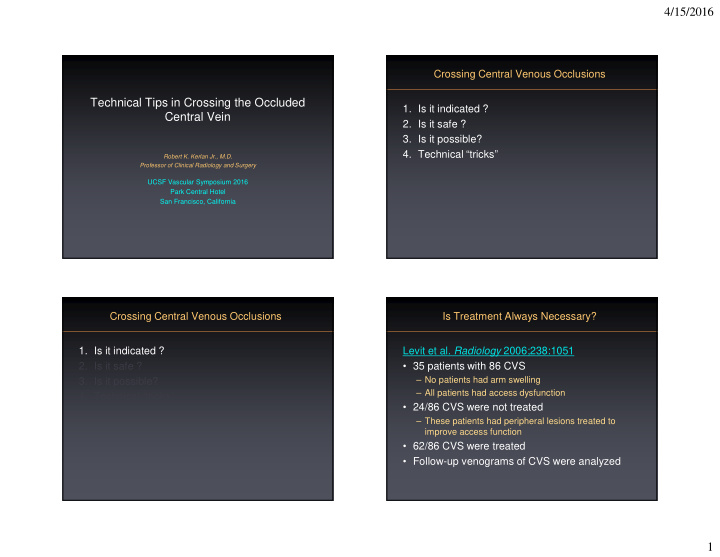



4/15/2016 Crossing Central Venous Occlusions Technical Tips in Crossing the Occluded 1. Is it indicated ? Central Vein 2. Is it safe ? 3. Is it possible? 4. Technical “tricks” Robert K. Kerlan Jr., M.D. Professor of Clinical Radiology and Surgery UCSF Vascular Symposium 2016 Park Central Hotel San Francisco, California Crossing Central Venous Occlusions Is Treatment Always Necessary? Levit et al. Radiology 2006;238:1051 1. Is it indicated ? 2. Is it safe ? • 35 patients with 86 CVS – No patients had arm swelling 3. Is it possible? – All patients had access dysfunction 4. Technical “tricks” • 24/86 CVS were not treated – These patients had peripheral lesions treated to improve access function • 62/86 CVS were treated • Follow-up venograms of CVS were analyzed 1
4/15/2016 Is Treatment Always Necessary? Is Treatment Always Necessary? Levit et al. Radiology 2006;238:1051 Levit et al. Radiology 2006;238:1051 – 12/24 (50%) CVS ’ s had no f/u venography • Untreated group • Treated group – 12/24 (50%) CVS ’ s had repeat venograms – 36/62 (58%) CVSs had no follow-up venograms – 26/62 (42%) had repeat venograms • 4 improved, 4 stable, 4 progression (mean diameter reduction • 3 improved, 0 stable, 23 progression (mean diameter improved) reduction reduction) • Treated CVS progressed to • No untreated CVS progressed to – Arm swelling (1) – Symptoms – Additional CVS (4) – Occlusion – Lesion requiring stent placement (4) Is Treatment Always Necessary? Crossing Central Venous Occlusions • No 1. Is it indicated ? 2. Is it safe ? • In patients who are minimally symptomatic and 3. Is it possible? have other identifiable causes for access failure, 4. Technical “tricks” the peripheral lesions should be treated and the CVSO should not be treated. 2
4/15/2016 Is it Safe? Is it Safe? Baumgartner F et al Texas Heart Institute Journal 1999 26:177 Is It Possible? Crossing Central Venous Occlusions You never know what you can cross until you try 1. Is it indicated ? 2. Is it safe ? 3. Is it possible? 4. Technical “tricks” 3
4/15/2016 Is It Possible? Crossing Central Venous Occlusions 1. Is it indicated ? 2. Is it safe ? 3. Is it possible? 4. Technical “tricks” Use a Co-axial System to Provide Support Technical “Tricks” 1. Use a co-axial system to provide support 2. Look for the string sign 3. Always advance sheath to point of maximum progress 4. Sharp re-canalization when blunt fails 5. Consider IVUS with sharp recanalization 4
4/15/2016 Look for the String Sign Always Advance Sheath to Point of Maximum Progress Sharp Re-canalization When Blunt Fails Sharp Re-canalization When Blunt Fails 5
4/15/2016 Sharp Re-canalization When Blunt Fails Sharp Re-canalization When Blunt Fails Sharp recanalization technique with Chiba needle • 65 cm Chiba (21G) • Curve at tip for directionality Rosch-Uchida TIPS Set BRK Transseptal Needles • 6 French sheath (25 cm) Cook Medical St. Jude Medical • 5 French Kumpe catheter (40 cm) Consider IVUS with Sharp Recanalization Sharp Re-canalization When Blunt Fails Outback LTD Re-entry Catheter PowerWire (RF Wire) Baylis Medical Cordis 6
4/15/2016 Thank you ! 7
Recommend
More recommend